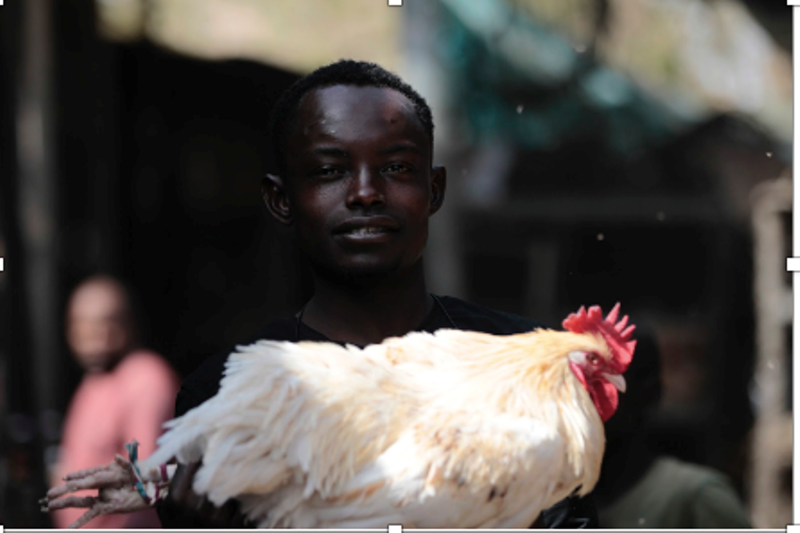
There is Sasso chicken named Russell running around the heart of Kenya. Russell will help the community by reproducing to help grow a chicken farm. He will protect the other chickens that are a food source to the population of the village.
I have a chicken named after me.
I wanted to teach my students about social justice.
My teaching partner and I have struggled to a certain extent with teaching Grade 12 Religion and Ethics students about social justice.
We have centred many of our discussions around Jesus’ words: 'I tell all of you with certainty, since you did it for one of the least important of these brothers of mine, you did it for me.' (Matthew chapter 25 verse 40)
A couple of weeks ago I implored them to live a generous life. Shane Willard said in relation to this that, “You see the face of God when you do something kind and generous for someone who can do nothing in return. This connects you to God. This shows you the heart of God.”
Lecture after lecture, statistic after statistic, YouTube clip after YouTube clip, playing inspirational songs, blasting them with inspirational quotes had us thinking our students had “compassion fatigue”. The many blank faces staring at us week by week confirmed this.
In a “light bulb” moment a few years ago we needed a challenge for our students…and it grew from there.
The $10 challenge.
The guidelines are pretty simple:
$10 to change the world.
- Here is a seed of $10.
- Your task is to use this $10 to change the world.
- You can choose to multiply it before you use it.
- All we ask in return is a written reflection on what you did with it so we can show it was used appropriately.
You have 4 weeks to complete this task.
They were handed a sealed envelope and were told not to open it until we told them to. The $10 and the guidelines were sealed in the envelope. The students opened the envelope and we sat down, observed and relaxed.
Stunned silence.
Nervous shuffling in seats.
Confused looks.
Smiles.
Excitement.
“Crunchy” eyebrows.
Students began conversations. Students stood up and spoke in front of their peers. They began to form “syndicates” to try and pool their resources. Students began to work out how much they could add to their money. Students switched off. Students opened their laptops and continued doing what students do when they open their laptops. Students wanted to know whether they could positively or negatively change the world.
“Can I keep it?”
“So, I can put this on the pokies?”
“Can I just give it to someone?”
“How much for a six pack these days?”
“What do you mean “used appropriately”?”
“How much to bake cupcakes?”
“Will my reflection be marked? How much am I supposed to write?”
“Can we buy a chicken for a third world village?”
“This won’t change the world.”
And this is all I heard.
Results
We had students buy chickens and goats to change a village.
We had students raise money for World Vision.
We had a student buy sanitary products for teenage girls in South Sudan.
We had a student give to Diabetes Australia- his brother had just been diagnosed.
We had students collect to stop sex trafficking of young girls through Destiny Rescue.
We had a student buy a packet of bait, drive over to pick up a mate who had been going through a rough time, and took him fishing.
We had students bake and sell. They used the money to buy a trolley full of groceries for a family in need.
We had a student buy a cap from Rio’s Legacy and has now signed up to be an advocate.
Student comments
You don’t need a lot of money to give. You could change someone else’s world with a dollar, it’s just a thought and a caring heart that counts. A desire that goes far beyond just satisfying yourself. This challenge made reflect on how for future budgeting, charity should be something I could consider. Instead of buying that coffee for myself, that money could go into someone else’s needs that are far greater than my own.
Imagine if everyone had put $5-10 dollars aside every month that would’ve probably just been wasted on fast food or wasteful things anyway, and contributed it to the world? Breaking stereotypes in a selfish western nature.
I learned the world is an incredible place if someone is passionate about an idea and is willing to make it work no matter what.
It does not require an assignment to do a small act that can have a big impact on someone. It’s easy to get caught up in your own life and become desensitised to those who struggle around you. I am inspired to carry out more selfless acts like this without instruction on my own accord.
Can $10 change the world? Absolutely! I used my money to help others far less fortunate than me and unable to thank me, but I don’t need thanks. I felt great about helping these communities and bringing hope to people who face much greater challenges. I enjoyed spending my money and getting nothing in return but a genuine feeling of helping my fellow man. “After all, the measure of a man’s greatness is not the number of servants he has, but the number of people he serves.” - John Hagee.
What would you do with $10 to change the world?
 Russell Modlin teaches English and Physical Education at a Christian School on the Sunshine Coast. He is married to Belinda and they have three children.
Russell Modlin teaches English and Physical Education at a Christian School on the Sunshine Coast. He is married to Belinda and they have three children.
Russell Modlin’s archive of previous article can be found at www.pressserviceinternational.org/russell-modlin.html

Russell Modlin is in his 30th year as a Secondary English and Physical Education Teacher. He has taught in Mackay, Brisbane, Alice Springs and currently on the Sunshine Coast. He is married to Belinda (26 years) and they have three sons- 2 have finished High School, 1 to go!
Russell Modlin’s archive of previous article can be found atwww.pressserviceinternational.org/russell-modlin.html